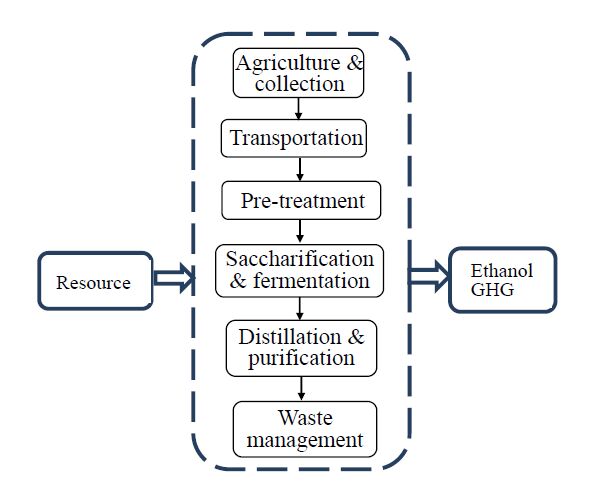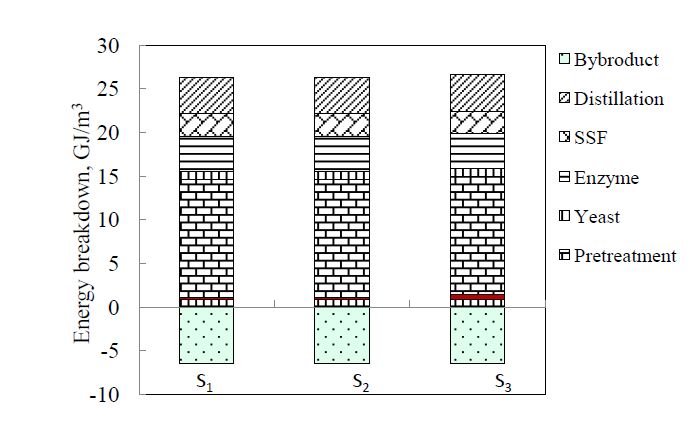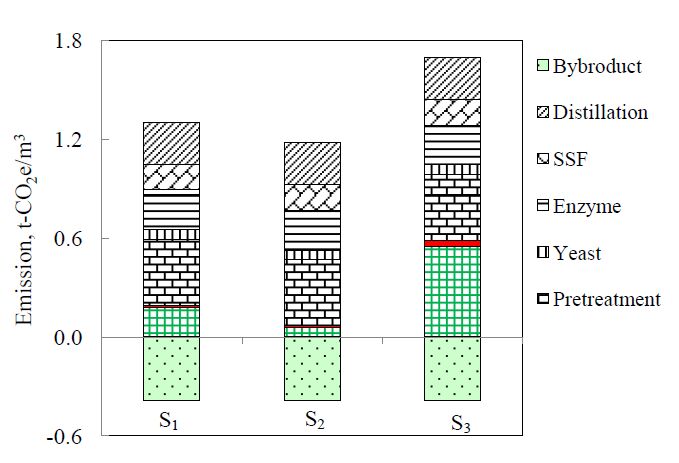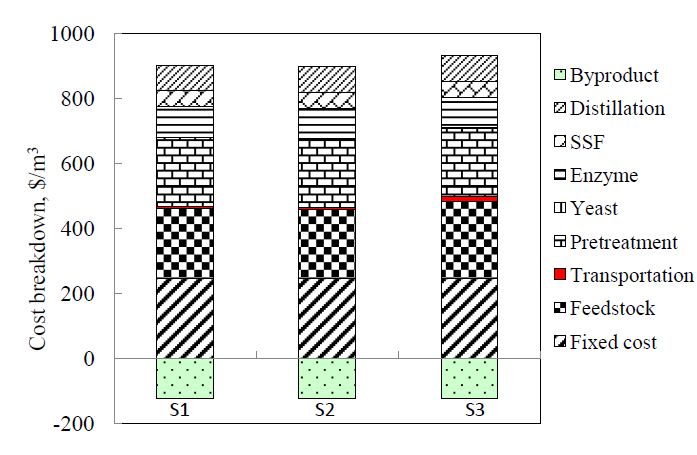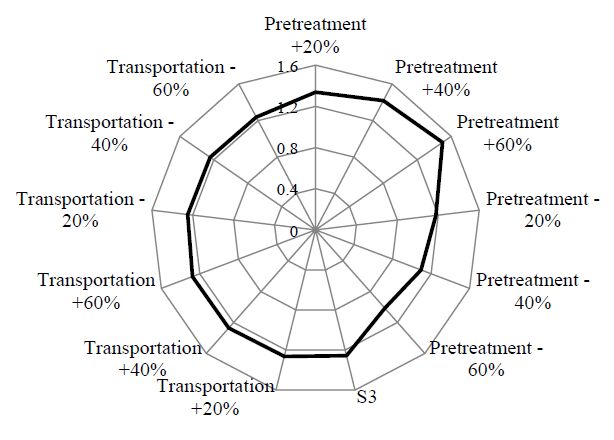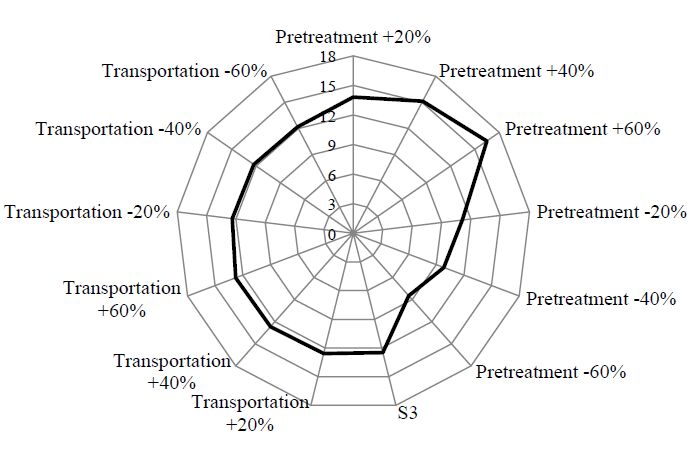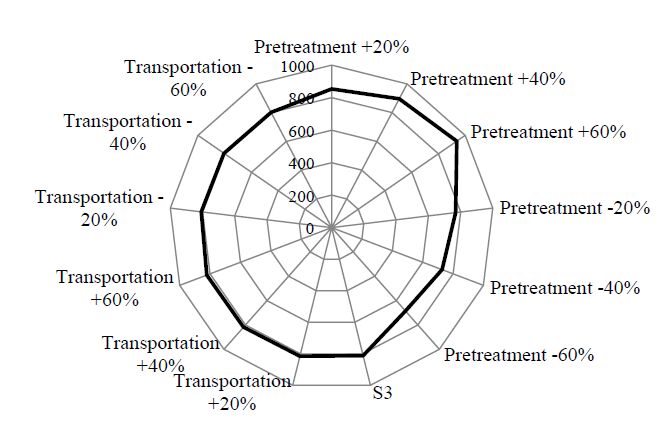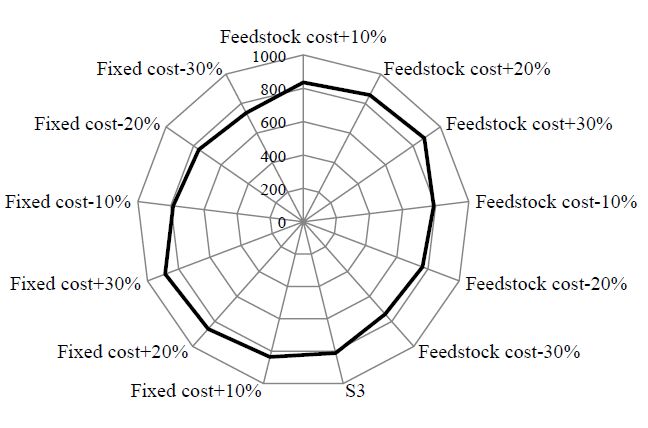1. Introduction
The rising cost of fossil fuels, uncertainty on their supply chains, and growing concerns about the environment have led to recognize the liquid biofuels as an alternative to fossil fuels, especially for transportation. In 2010, secondary transportation fuel consumption was reported to be 2595 PJ in Canada, a growth of 38.2% from 1990 level [1]. In Canada, gasoline fuel must contain at least 5% renewable fuel. However, in 2010 ethanol contributed only 1.7% and 3.2% to total transportation energy and motor gasoline, respectively [1], which portrays the substantial demand for ethanol in Canada. Several authors reported that renewable fuels, reduce greenhouse gas (GHG) emissions and enhance the farm economy [2,3]. Biofuels from lignocellulosic biomass (agricultural and forest residues, and energy crops) shown minor competition with food or feed crops, thus their production are encouraged [4,5].
Although ethanol production from lignocellulosic biomass has been emphasized, the concern about soil fertility and structural stability restricts the collection of agricultural residues [6,7]. Farmers are also reluctant to remove crop residues from their farms [8]. Forestry by products, municipal solid waste, agricultural residues, and energy crops are the potential sources of lignocellulosic biomass. The technical, economic and sustainability constraints in Ontario conditions also limit their supply to renewable energy industries [9]. The use of forestry wastes for liquid biofuels are also restricted due to their enormous demand by solid biofuels industries. Miscanthus is a promising energy crop, which can be cultivated on marginal or inferior land (the land is not suitable for conventional crops). Miscanthus adds carbon to the soil and safeguards against erosion [10], and has an important role in sustainable energy production [11,12,13].
Kludze, et al. [10] noted that Ontario has an adequate land base for producing miscanthus to meeting/surpassing numerous viable uses of lignocellulosic biomass without significantly affecting food crops supply. Although the life cycle (LC) of lignocellulosic ethanol has been extensively studied, the ethanol from miscanthus has received limited attention [14,15] that mostly focus on biorefineries, crop location and agricultural practices. This study evaluates the LC of ethanol from miscanthus by enzymatic hydrolysis process, considering three scenarios to determine its environment and economic viability in Ontario, Canada.
2. Materials and Methods
2.1. Study area and assumptions
Ontario is located in the east-central region (48˚N to 83˚W) of Canada (60˚N to 95˚W) and consists of two major regions (southern and northern). The southern region is further divided into four sub-regions, namely southern-, western-, central-, and eastern Ontario (SI-1; SI: supporting information). Total land area in Ontario is 91.8 million ha. The tillable and arable land (suitable for growing conventional crops) areas are reported to be about 4.4 and 3.6 million ha, respectively. The land in Ontario has been classified into seven classes (SI-2). It is also grouped as the prime- (classes 1, 2 & 3) and marginal lands (classes 4 & 5). The productivity of miscanthus is dependent on the type of land (land classes) (SI-3). The land classes are scattered throughout various regions and the area under different land classes varies from region to region (SI-4). The LC of ethanol is evaluated based on three scenarios (Table 1). Miscanthus yield, emissions from cultivation, and feedstock cost for various scenarios are assumed to be the average yield, net emission and cost of corresponding land classes. Cradle to gate scenario is adopted to outline the system boundary (Figure 1) to determine the net energy consumption, production cost and GHG emissions from the LC of ethanol from miscanthus.
Table 1. Scenarios of this study.
|
Scenarios
|
Descriptions
|
^Yield,
|
*Feedstock cost
|
|
|
|
tDM/ha
|
$/tDM
|
|
S1
|
All classes of land are used for miscanthus
|
10.02
|
66.09
|
|
S2
|
Only prime land is used for miscanthus
|
10.86
|
64.56
|
|
S3
|
Only marginal land is used for miscanthus
|
8.35
|
71.50
|
Prime land: Classes 1, 2 & 3; Marginal land: Class 4 & 5; *Breakeven cost of miscanthus
(Source: ^*[10]). Transportation distances are 17.7, 18.5, and 49.3 km for S1, S2 and S3, respectively.
|
Both the estimated and literature data have been used in this study. Table 2 shows the summary of processes for which data are collected from the literature. The functional unit (FU) is considered to be 1 m3 anhydrous ethanol. Energy consumption in ethanol processing plant construction, production of transportation and other machineries are not considered. Energy input in the forms of feedstock and labor also are not considered. Emission has been estimated in equivalents (CO2e; i.e., global warming potential for 100 year). The heat recovery (from lignin; hereafter referred to by-product) in the process is subtracted from total energy consumption to estimate the net energy consumption. Net emission is the difference between emission from input energy, and the sum of carbon dynamics, and the amount of emission offset by the by-product recovered from the system.
Table 2. Summary of parameters for which data are collected from literature.
|
Parameters/Systems
|
Actual data
|
Sources
|
|
Miscanthus cultivation (kg CO2e/tDM)
|
16.94 to 167.67
|
[16]
|
|
Feedstock cost ($/tDM)
|
64.56 to 71.5
|
[10]
|
|
*Crushing (size 3 mm) (kWh/kg)
|
0.06095
|
[17,18]
|
|
Ethanol processing plant construction
|
$38 million
|
[19]
|
|
No. of labor (persons)
|
23
|
[19]
|
|
Enzyme:
|
|
|
|
Energy consumption (kWh/L)
|
0.802
|
[20]
|
|
Yeast ($/gallon)
|
0.01
|
[21]
|
|
Vacuum extractive fermentation & distillation (MJ/kg hydrous ethanol)
|
7.525
|
[22]
|
|
Purification (MJ/kg ethanol)
|
1.085
|
[23]
|
|
Ethanol yield (L/kg-dry miscanthus)
|
0.305
|
[24,25,26,27]
|
| Note: Plant capacity is 20000 kL/year; labor cost $46000/person/year; *assumed to be same that of straw; boiler efficiency 80% (Mani, et al., 2009); $: Canadian dollar.
|
2.2. Miscanthus cultivation
Miscanthus grows in tropical, subtropical and temperate regions; however, does not grow at a temperature below 6 °C. Thus, miscanthus can be grown in all the regions of Ontario and its cultivation is noted to be economically feasible [10,28]. Miscanthus stands persist for fifteen to twenty years. Miscanthus yield increases for the first 3 years and then remains constant for the remaining years. Yield varies from region to region [9]. Miscanthus requires very low agro-chemical [29]. Typically, late winter or early spring is the harvesting period for miscanthus; thus, contains low moisture at harvest (15-20%) [10,16,28,29]. A portion of agricultural land in northern Ontario has been excluded from this study because of its short growing periods (100-145 frost free days). The net emission from agriculture (hereafter referred to feedstock) is estimated based on energy inputs in agriculture) and the carbon dynamics, i.e., carbon storage in all pools (SI-5).
2.3. Transportation
Harvested and baled miscanthus is transported to the ethanol processing plant by 6 m (20 feet) tailor trucks (loading is considered to be 75%). The moisture content in harvested miscanthus is considered to be 15% and the bulk density of baled miscanthus is 218 kg/m3 [28]. The required transportation energy is determined based on the loading capacity of the tailor trucks, feedstock moisture content and specific volume of baled miscanthus. The ethanol plant production capacity is considered to be 20,000 m3/year. Miscanthus transportation distance is workout based on a published methodology [30, SI-6]. Roads and channels in the farm area are assumed to be 2% of tillable land in the farm area. The transportation distance depends on the scenarios and it varies from 17.7-49.3 km.
2.4. Ethanol production
2.4.1. Pretreatment
Physicochemical or chemical or biological pretreatment is a prerequisite to improve components digestibility and improve ethanol yield from miscanthus [31]. Although different pretreatments are employed to miscanthus (ammonia fiber expansion, acid hydrolysis, NaOH pretreatment, wet explosion, etc. and liquid hot water (LHW)), the lime pretreatment is adopted in this study [32].
2.4.2. Fermentation and distillation
An innovative fermentation and distillation process is adopted in this study [22]. Pretreated miscanthus slurry (solid 10%) is then fermented at 33 °C for 72 h (SSF: simultaneous saccharification and fermentation). Although the reported enzyme loading for ethanol production from miscanthus varies from 10-20 FPU g−1 cellulose [31,33], it is considered to be 8.04 FPU g−1 miscanthus. Similarly, the ethanol yield also reported to be varied from 0.189-0.427 m3 t−1. However, in this study ethanol yield is considered to be 0.305 m3 t−1 feedstock.
2.4.3. Enzyme and yeast production
Energy required for enzyme is estimated based on the reported enzyme cost ([20]; enzyme loading: 15 FPU g-1 cellulose ≈ 19263 FPU L−1; electricity price 4.2¢ kWh−1 in 1997). Then, the cost of enzyme is calculated (considering the electricity price in Ontario in 2012 and the assumed enzyme loading of this study). Similarly, energy consumption in the yeast production process is determined based on the reported cost of yeast ($2.7 m−3) [21].
2.4.4. Waste management
The waste stream of lignocellulosic ethanol consists of solids (lignin; hereafter referred to by-product) and liquid (wastewater). The waste stream is centrifuged into solid and liquid streams. The dried lignin (wasted heat from the boiler is used to dry lignin) is assumed to be combusted in the boiler for heat recovery, and biogas is produced from wastewater anaerobic digestion. Biogas generated in the anaerobic digestion of wastewater offsets the energy consumed in waste management processes and heat recovered from lignin offsets a portion of the supplied process heat. The cost and emission that attributed to the recovered heat is ascertained with the cost and emission factor of liquid natural gas (LNG).
2.5. Net energy consumption
Net energy consumption is calculated from the difference between the sum of the energy consumption in each process and the amount of energy recovered from the by-product.
2.6. Cost analysis
The cost of ethanol is estimated considering both the fixed and variable costs. Yearly operation period and economic life of the plant is assumed to be 350 days and 20 years, respectively. The interest rate and maintenance cost are considered to be 3% and 2%, respectively. The feedstock cost is considered to be about 63-74 $ tDM-1 depending on the scenarios, which are the breakeven cost of miscanthus [10].
2.7. Sensitivity analysis
Sensitivity analysis is used to determine the dependence of a certain inputs/outputs on the life cycle of a product, process or activity. Consequently, the effect of the variation in individual parameters was performed to better understand their impact on net energy, emission and cost of the life cycle of ethanol. Variations are considered to be ±20 to ±60% for pretreatment and transportation. However, in the case of feedstock and fixed cost, variations are considered to be ±10 to ±30%.
3. Results
3.1. Net energy consumption
Energy intakes in each stage and energy recovery from by products are estimated to represent the energy breakdown of the ethanol production process (Figure 2). The main energy consumer is found to be feedstock cultivation followed by pretreatment, distillation, enzyme, SSF, transportation and yeast for each scenario. The consumption of transportation energy slightly varied because of the variation in distance among scenarios. The transportation distance is found to be shortest and longest for scenario-1 (S1) and scenario-3 (S3), respectively, because of the difference among corresponding land area. The net energy consumption varies from 12.1-12.5 GJ m−3. A portion of energy feed into the process is offset by the heat recovered from the by-product which has a robust role in the net energy consumption estimation. It is noted to be sensitive to coproduct allocations and assumptions of the study [34,35]. Thus, energy intake differed from other studies because different feedstock has been used and different assumptions are made in those studies [17,18,35,36]. However, the net energy consumption may vary, if different miscanthus variety, cultivation and pretreatment methods are adopted.
3.2. Greenhouse gas emission (CO2e)
Figure 3 shows the emission from each stage of the LC of ethanol for different scenarios. The emissions from different stages are found to be proportional to the corresponding energy and resource consumption (fossil energy and electricity) except feedstock because carbon dynamics offsets a major part. The main contributor is the pretreatment process followed by distillation, enzyme, SSF, transportation and yeast, except S3 where feedstock is emerged as the main hotspot because of the positive carbon dynamics (i.e., carbon released to the atmosphere). Consequently, emissions from feedstock for S1, S2 and S3, are found to be 0.18, 0.06 and 0.55 t-CO2e m−3, respectively. The emissions from transportation slightly varied among different scenario because of the variation in transportation. The carbon dynamics are noted to be dependent on the land classes, crop replacement/rotation and biomass yield [10,16]. The emission from feedstock is the highest in the case of marginal land (S3) and the lowest for prime land (S2). These variations might not only because of land type, but also the region and crop rotations, because various crop rotation were considered for different scenarios (S1, S2 and S3).
LC net emissions are found to be 0.9, 0.7 and 1.3 t-CO2e m−3 for scenarios S1, S2 and S3, respectively, which seems to be mainly dependent on the carbon dynamics. These values indicate that GHG emission can be abated if ethanol is produced from miscanthus (compared to fossil gasoline: 1.5 t-CO2e L−1 ethanol equivalent), even it is cultivated on marginal land. It is worthy to mention that the heat recovered from by-product and the carbon dynamics have a robust contribution to offset a portion of the emission of the LC of ethanol. The estimated net emissions from the LC of ethanol revealed that miscanthus based ethanol industry can be environmentally beneficial even miscanthus is grown on marginal land in Ontario and ethanol produced with the adopted technologies.
3.3. Net production cost
The fixed cost is found to be the main contributor to the net production cost followed by the feedstock, pretreatment, distillation, SSF, transportation and yeast (Figure 4). There is a slight variation in fixed, feedstock, and transportation cost which is yielded by the difference in feedstock production cost and the transportation distance among the scenarios. The fixed- feedstock-, and transportation cost varied from 246.4 to 247.5, 212.0 to 234.5, and 6.2 to 17.2 $ m−3, for scenarios S1, S2, and S3, respectively. The estimated net production cost for S1, S2, and S3 are 781.6, 776.6, and 811.5$ m−3, respectively. It is noteworthy to mention that the breakeven feedstock cost has been considered for the production cost estimation, which may vary depending on the biomass logistics and farmers profit margins. Despite, a wide variations are reported for lignocellulosic ethanol[17,35,37,38,39], the estimated ethanol production cost seems to be reasonable and comparable. Production cost is also dependent on the conversion technology, enzyme loading, feedstock, allocation methods and plant sizes [35,40]; consequently, production cost may vary, if different conversion methods, allocation, and plant sizes are considered.
3.4. Sensitivity analysis
LCA methodology identifies the potential hotspots of product, production system and activity. The potential hotspot of this study is identified to be the feedstock in case of energy consumption and emission; however, the fixed cost is emerged to be the main hotspot in the case of production cost. A wide variation is also observed in the case of transportation distance (10 to 49 km) and carbon dynamics (−0.5 to 0.03 dry t C ha−1 year−1; [16]) among the scenarios. Liquid biofuels production is rapidly increasing, and affecting land allocation among crops [41]. Consequently, better profit margin or profit taking opportunities may lead commercial biofuel production to target higher-quality lands and food crops instead of marginal or low-quality land. Although the carbon dynamics of scenario S3 is greater than that of others (S1 and S2), marginal land can be used to grow miscanthus [10,16] and environmental benefit can be achieved compared to fossil gasoline.
Aboveground minimum source carbon requirement is noted to be 1.8±0.44 to 2.5±1.0t/ha/year depending on the tillage systems [42]. Jeschke [43] has reported that about 50 to 60% crop residues can be collected without deteriorating the soil quality and productivity. On the other hand, roots and rhizomes shared 39% of the total biomass produced in the case of miscanthus, which indicates that miscanthus can be harvested for biofuels, perhaps without jeopardizing soil quality and productivity. The breakeven feedstock cost has also been used for cost estimation, which may vary depending on the profit margin of stakeholders and biomass logistics. Consequently, the variation in transportation, pretreatment process, fixed- and feedstock cost are investigated (based on the third scenario: S3).
Figure 5 shows the effect of variation in transportation distance and pretreatment energy consumption (variations are considered to be ±20 to ±60%) on net energy consumption, emissions and cost. Depending on the severity of the variation, the net energy consumption, emissions and production cost varied from 10.7 to 17.3 GJ m−3 (Figure 5a), 1.1 to 1.6 t-CO2e m−3 (Figure 5b) and 727.7 to 937.2 $ m−3 (Figure 5c), respectively. The effect of the change in pretreatment energy consumption seems to be more robust than that of transportation distance because the pretreatment process consumed a greater amount of energy than that of transportation. Figure 6 represents the effect of the variation (±10 to ±30%) of feedstock cost on the net production cost. It varies from 735.2 to 885.7 $ m−3 and reliant on the severity of the variation. This study reveals that miscanthus grows on the marginal land in Ontario could be a potential lignocellulosic feedstock for ethanol industries and avoid any competition with food crops for prime land, help Ontario improving her food and energy security.
4. Discussion
Although GHG emissions and ethanol production cost from miscanthus are observed to be viable in Ontario for all scenarios, S2 (prime land) is seemed to be more attractive, not only for emission abatement but also for the cost reduction. Consequently, farmers or commercial biofuels producers may target prime land because of greater profit margin. Therefore, miscanthus cultivation for ethanol or any other biofuels needs to be regulated to avoid any such competition for the quality land. This initiative may also minimize fuel vs food debate. Agri-industrial and environmental policies are required to be enacted to support and encourage stakeholders on miscanthus based ethanol industry (for example FiT: fit in tariff on ethanol production or any other incentives for agri-industry), especially miscanthus grown on the marginal land.
Genetically modified (GM) crops improves yield and reduces chemical fertilizers or water requirement, and improves income [44]. Consequently, adaptation of GM miscanthus which may be grown on marginal land, improve farmer profit margin, and reduce net emission from the LC of ethanol. It is also worthy to note that carbon dynamics play an important role in emission estimation, which is dependent not only on the land classes but also on the crop rotation or displacement. A careful consideration has to be placed for crop rotation to improve carbon dynamics (C uptake from the atmosphere), avoid food vs fuel debate, and reduce GHG emission. Adaptation of renewable energy policy for miscanthus based ethanol industry may not only encourage investors and other stakeholders, but also attract more investment, improve farm income and enlarges farm economy in Ontario. Finally, these initiatives would help Canada meet the demand for ethanol, and achieve renewable energy and emission abatement target.
5. Conclusion
Although a slight variation is observed in the case of net production cost and energy consumption among the scenarios, the variation is found to be robust in the case of net emission where carbon dynamics play an important role. Both the environment and economic benefit can be gained from miscanthus based ethanol even miscanthus is grown on the marginal land. Thus, it is emerged as a promising feedstock for ethanol industry in Ontario, which may avoid any sort of competition with food crops for higher quality land, improve farm income and rural economy, and help meeting the ethanol demand, and achieving GHG emission abatement target of Canada.
Acknowledgments
We are grateful to the NSERC Discovery (Grant No. 400495), for financial support in this study.
Conflict of Interest
All authors declare no conflicts of interest in this paper.









 DownLoad:
DownLoad: 